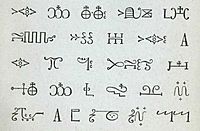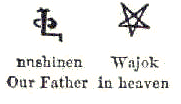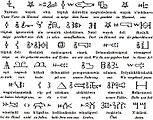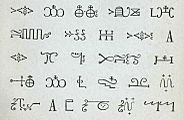Miꞌkmaw hieroglyphic writing facts for kids
Quick facts for kids Miꞌkmaq hieroglyphsSuckerfish script Gomgwejui'gasit |
|
|---|---|
 |
|
| Type | Logographic |
| Spoken languages | Miꞌkmaq |
| Time period | 17th–19th century (logographic); date of precursors unknown |
| Note: This page may contain IPA phonetic symbols in Unicode. | |
Miꞌkmaw hieroglyphic writing is also known as Suckerfish script. In the Mi'kmaw language, it is called Gomgwejui'gasit. This was a special way of writing for the Miꞌkmaw people. Today, they use different writing systems based on the Latin alphabet. The Mi'kmaq are a First Nation group in Canada. Their traditional land, called Mi'kma'ki, covers much of the Maritimes provinces. This includes all of Nova Scotia, Prince Edward Island, and parts of New Brunswick and Newfoundland and Labrador.
These special symbols, or gomgwejui'gaqan, came from older pictures and petroglyphs. They are mostly logograms, which means each symbol represents a whole word or idea. They also had parts that showed sounds, like an alphabet. The name gomgwejui'gasultijig comes from gomgwej, which means "sucker fish". These fish leave tracks on muddy river bottoms that look like the symbols. Because the Mi'kmaw language has different ways to spell, you might also see Suckerfish script called komqwejwi'kasikl or gomgwejui'gas'gl.
Contents
What Kind of Writing Is It?
For a long time, experts have wondered if the first Miꞌkmaw "hieroglyphs" from the 1600s were a full writing system. Or were they just pictures used to help people remember things? In the 17th century, a French missionary named Chrétien Le Clercq changed the Miꞌkmaw symbols. He made them into a system where symbols stood for words. He did this to help teach Catholic prayers and lessons to the Mi'kmaq people.
In 1978, two experts, Ives Goddard and William Fitzhugh, said the system before the missionaries was only for remembering things. They believed it could not be used to write new stories or ideas.
However, in 1995, David L. Schmidt and Murdena Marshall published a book. It showed prayers and stories written with these hieroglyphs. These were the same symbols French missionaries used in the late 1600s. Schmidt and Marshall showed that these hieroglyphs worked as a complete writing system. They said it was the oldest writing system for a native language in North America, north of Mexico.
How the Writing System Developed
Father Le Clercq was a Roman Catholic missionary. He arrived in New France in 1675, on the Gaspé Peninsula. He saw Miꞌkmaw children writing symbols on birchbark. Le Clercq then changed these symbols to write prayers and church lessons. He even made new symbols when he needed them. The Mi'kmaq also used porcupine quills to press the symbols directly into the bark.
This new writing system became very popular among the Miꞌkmaq. They continued to use it even into the 1800s. We don't have old records or archaeological finds of these symbols from before the missionaries arrived. So, it's not clear how old the original memory symbols were. We also don't fully know how these symbols are connected to older Miꞌkmaq petroglyphs, which were carved into rocks before Europeans came.
Ancient Rock Carvings
At Kejimkujik National Park and National Historic Site, you can find petroglyphs. These are carvings in slate rocks that show the "life-ways of the Mi'kmaw." They include written hieroglyphics, human figures, Mi'kmaq houses, decorations like crosses, sailing ships, and animals. These carvings were made by the Mi'kmaq, who have lived in the area for a very long time. The petroglyphs date from ancient times up to the 1800s. In 1912, a Mi'kmaq healer named Jerry Lonecloud copied some of these petroglyphs. He then gave his copies to a museum.
Another Missionary's Work
Pierre Maillard, another Roman Catholic priest, created his own system of hieroglyphics in the winter of 1737–38. He used these symbols to write down important prayers and responses for church lessons. This helped his followers learn them more easily. We don't know if Maillard knew about Le Clercq's work. Maillard created many writings in the Mi'kmaw language. These writings continued to be used by the Miꞌkmaq people into the 1900s.
Examples
-
The Ave Maria.
See also
 In Spanish: Jeroglíficos Micmac para niños
In Spanish: Jeroglíficos Micmac para niños





